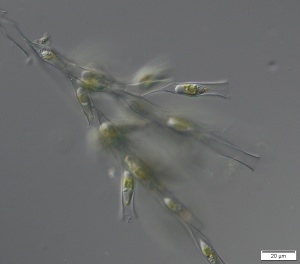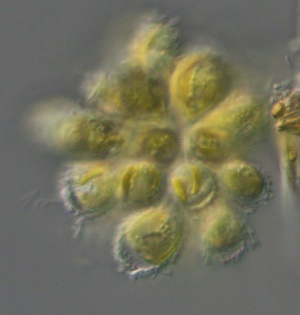Difference between revisions of "Algae around UConn"
From EEBedia
m |
m |
||
| Line 1: | Line 1: | ||
==Biodiversity hidden to the naked eye== | ==Biodiversity hidden to the naked eye== | ||
| − | Microorganisms are incredibly diverse. A small sample of water from a local pond can contain dozens of species - some related to plants, some related to fungi, and some belonging to completely different, ancient lineages of eukaryotes. Algae are a subset of this diversity: they are organisms that contain a photosynthetic organelle (plastid). Here are a few examples of the charismatic algae found in the vicinity of the University of Connecticut | + | Microorganisms are incredibly diverse. A small sample of water from a local pond can contain dozens of species - some related to plants, some related to fungi, and some belonging to completely different, ancient lineages of eukaryotes. Algae are a subset of this diversity: they are organisms that contain a photosynthetic organelle (plastid). Here are a few examples of the charismatic algae found in the vicinity of the University of Connecticut. |
| − | *Dinobryon is a colonial flagellated alga from the class Chrysophyceae, a member of the [http://tolweb.org/Stramenopiles/2380 Stramenopiles]. | + | *''Dinobryon'' is a colonial flagellated alga from the class Chrysophyceae, a member of the [http://tolweb.org/Stramenopiles/2380 Stramenopiles]. |
| − | [[Image:Dinobryon.jpg|thumb|left|''Dinobryon cf. cylindricum'' from Walker Reservoir, Vernon, CT]] | + | [[Image:Dinobryon.jpg|thumb|left|''Dinobryon'' cf. ''cylindricum'' from Walker Reservoir, Vernon, CT]] |
| + | *''Synura'' is a genus of the Synurophyceae, a sister group to Chrysophyceae. Their plastids give members of both groups a typical golden-brown color. Synurophyceae have cells covered with siliceous scales. Detailed examination of scale morphology is often needed for species identification. Colonies of ''Synura'' are not the most elegant of swimmers, but are fun to [[https://www.youtube.com/watch?v=yYgIEOfo8J0&feature=youtu.be watch]] tumbling around. | ||
| + | [[Image:Synura.jpg|thumb|middle|''Synura'' cf.''uvella'' from Walker Reservoir, Vernon, CT]] | ||
Revision as of 18:15, 19 June 2014
Microorganisms are incredibly diverse. A small sample of water from a local pond can contain dozens of species - some related to plants, some related to fungi, and some belonging to completely different, ancient lineages of eukaryotes. Algae are a subset of this diversity: they are organisms that contain a photosynthetic organelle (plastid). Here are a few examples of the charismatic algae found in the vicinity of the University of Connecticut.
- Dinobryon is a colonial flagellated alga from the class Chrysophyceae, a member of the Stramenopiles.
- Synura is a genus of the Synurophyceae, a sister group to Chrysophyceae. Their plastids give members of both groups a typical golden-brown color. Synurophyceae have cells covered with siliceous scales. Detailed examination of scale morphology is often needed for species identification. Colonies of Synura are not the most elegant of swimmers, but are fun to [watch] tumbling around.

